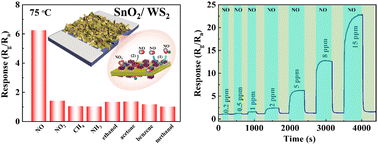Oxygen vacancy engineered tin dioxide/tungsten disulfide heterostructure construction for effective NO sensing†
Abstract
High-performance NO gas sensors operating at low temperature are urgently desirable for both civilian and industrial purposes. However, it remains a great challenge to prepare tin dioxide (SnO2)-based hybrids in a simple and effective way and realize low operating temperature and high sensitivity/selectivity simultaneously. Here, we demonstrate the successful construction of a SnO2/tungsten disulfide (WS2) heterostructure using a simple hydrothermal method. By taking advantage of SnO2 nanocrystals dispersing uniformly on WS2 nanosheets and the increased oxygen vacancies as well as the existence of Sn2+, the SnO2/WS2 hybrid heterostructure shows a significant improvement in response and a much better selectivity to NO compared with the SnO2 microspheres. More importantly, the response (Rg/Ra) of the SnO2/WS2 hybrid to 5 ppm NO is 6.24 at 75 °C, which is 6.10- and 4.21-fold higher than that of the SnO2 microspheres and WS2 nanosheets, respectively. Thus, the hybrid heterostructure displays good performance with better selectivity, shorter response/recovery time and good repeatability, indicating its potential application in monitoring NO gas exhaled by humans.

- This article is part of the themed collection: Journal of Materials Chemistry C HOT Papers


 Please wait while we load your content...
Please wait while we load your content...